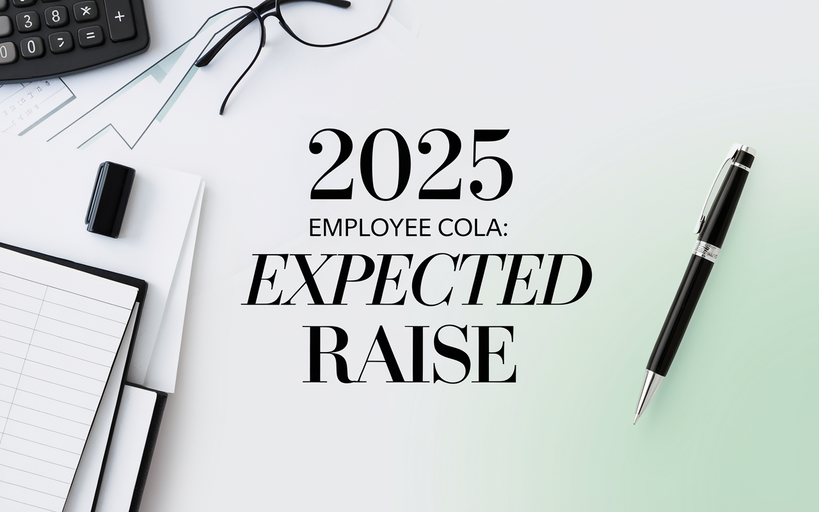2025 Federal Annuitant COLA
Understanding the 2025 COLA Landscape
If you’re a federal employee or military retiree, you’re probably well aware that each new year often brings adjustments to your monthly benefits and pay. These adjustments, known as Cost-of-Living Adjustments (COLAs), are designed to help your income keep pace with inflation. Extra dollars in your paycheck—whether that’s your pension or Social Security—can provide welcome relief in the face of rising everyday expenses. And for 2025, there’s some noteworthy news to share: an official 2.5% COLA for Social Security beneficiaries, as well as a slight difference for those under the Civil Service Retirement System (CSRS) compared to the Federal Employees Retirement System (FERS).
In simple terms, a COLA is a small boost added to your benefits, meant to help preserve your buying power in retirement. If you’ve been seeing headlines about a 2.5% cost-of-living increase for employees, you might also notice that not everyone receives precisely the same percentage. Most Social Security recipients and CSRS retirees are set for 2.5%, while FERS retirees will receive a somewhat smaller 2.0%. Despite that distinction, the increase still represents an important lifeline—especially if your monthly budget is already feeling the pinch from higher rents, healthcare costs, and grocery bills.
So why should this matter to you? After all, 2.5% may not sound like a life-changing sum. But if you’re preparing for retirement, already retired, or looking at a transition out of federal service, even modest increases can compound over time. It can mean extra breathing room in your monthly budget. More often than not, it’s one piece of a larger puzzle—how to align your benefits, savings, and investments in a way that supports your financial goals. If you’d like to learn more, consider exploring the biggest financial considerations when retiring from a federal career.
The CPI-W and Economic Factors Shaping the 2.5% Adjustment
The 2025 COLA is calculated using the Consumer Price Index for Urban Wage Earners and Clerical Workers (CPI-W). In the months leading up to the announcement, analysts look at how much prices for goods and services have inched upward—think groceries, medical care, transportation, and so on. By comparing inflation data in the third quarter of one year to the same period the year before, the government determines the next year’s COLA.
You may recall that not long ago, inflation soared to levels we hadn’t seen in decades, culminating in an 8.7% COLA back in 2023. Then, in 2024, the COLA dropped to 3.2%. This year, cooler inflation rates lead us to a 2.5% adjustment for most recipients in 2025. While this dip can seem disappointing for anyone who’d gotten used to higher raises, it does reflect the way inflation has eased off since its earlier spike. And even 2.5% appears well within the more typical range for year-over-year inflation growth.
Below is a table that highlights how the 2025 COLA compares to prior years—particularly for Social Security recipients and federal retirees. Notice how FERS differs from the standard Social Security (and CSRS) figures:
| Year | COLA (%)(Social Security, CSRS) | COLA (%)(FERS) | Effective Date |
|---|---|---|---|
| 2023 | 8.7% | 7.7% | January 2023 |
| 2024 | 3.2% | 2.2% | January 2024 |
| 2025 | 2.5% | 2.0% | January 2025 |
From 7.7% to 2.2%, and now 2.5% (2.0% under FERS), the range can feel like a bit of a rollercoaster. While we’d all like consistent, higher increases in benefits, these adjustments simply respond to what’s happening in the wider economy. If inflation spikes, COLA might be higher; if inflation cools, the raise tends to shrink.
What the 2025 COLA Means for You and Your Benefits
One of the most common questions federal employees and retirees ask is, “When will I see my paycheck or monthly benefits go up?” For Social Security recipients, the standard effective date is January 2025, which means you’ll likely notice the bump in your first check of the new year. Supplemental Security Income (SSI) participants see their increases slightly earlier—December 31, 2024—because SSI payments hit accounts at the start of each month.
Federal annuities and military pensions also adopt COLA increases around the same time, though if you’re under FERS, your adjustment is usually somewhat different, as shown above. The 2025 COLA for CSRS tracks the Social Security rate of 2.5%, while FERS sees 2.0%. Although that might seem a small difference, it can add up over the course of a long retirement.
Social Security estimates suggest that the average recipient will gain about $50 per month from the 2.5% increase in 2025. Similarly, CSRS or FERS retirees will see a modest bump in their monthly annuity—though the exact amount you see depends on the size of your benefit as well as which system you’re under. And then there’s the private sector, where salary increases are forecast to hover around 3.5% in 2025, on average. If you or your spouse still have some private employment income, that discrepancy could be part of your household’s overall financial picture.
Strategizing Your Financial Future with the 2025 COLA
No matter the size of the adjustment, COLA exists to keep you from falling behind when prices creep up. That said, inflation doesn’t always slow down just because a government report says so. From groceries to home repairs, everything adds up, and COLAs can sometimes lag behind real-world price hikes—especially if a particular pocket of the economy heats up unexpectedly.
One resource that highlights how costs outpace COLA is the annual retirement survey conducted by the Senior Citizens League (TSCL). In 2024, for example, monthly budgets for housing, prescription drugs, and basic essentials continued to climb faster than many retirees’ incomes. For 2025, a 2.5% or 2.0% COLA might close the gap a bit, but it likely won’t wipe away all your inflation concerns.
Below is a hypothetical table—based on typical expenses seniors have—to give you a sense of how costs can shift from year to year. Note how, even with a 2.5% Social Security adjustment, certain expense categories can rise by 3%, 4%, or even 5%.
| Expense Category | 2024 Average | 2025 Projected | Change (%) |
|---|---|---|---|
| Housing | $1,200 | $1,250 | 4% |
| Food | $400 | $420 | 5% |
| Healthcare | $300 | $310 | 3% |
From this small snapshot, you can see how the uptick in living costs may, in some cases, outpace a 2.5% or 2.0% adjustment. To make the most of your future benefits—even if they’re smaller than you’d hoped—consider revisiting your monthly budget or rethinking your retirement-savings timeline. Exploring ways to reduce recurring expenses can help your COLA stretch further.
If you’re still actively working for the federal government, it’s important to recognize that each pay raise or annual adjustment might factor into your high-three average salary when the time comes to calculate your pension. How are Federal Pay Raises Determined? Understanding this process is one reason many workers reach out to professional planners who specialize in federal benefits.
Looking Ahead to 2026 and Beyond
Another question many federal employees and retirees have is: “Will COLA stay this low?” Truthfully, no one can forecast precisely how inflation will behave. Initial guesses suggest a similar range for 2026—somewhere around 2%–2.5%, if inflation remains moderate. But as we learned in recent years, the slightest shakeup in global supply chains or energy markets can dramatically alter inflation trends in a short period.
Because COLA is not guaranteed to match real-world costs exactly, it’s equally important to keep an eye on other aspects of your retirement equation. For instance, if you reach certain earnings thresholds, you might see changes to your Social Security taxable maximum—something the Social Security earnings test can help clarify. And if you’re a higher earner, any ups and downs in that threshold can affect how much you contribute or how your benefits are ultimately calculated.
Even if inflation remains in check, a small change can have a ripple effect on everything from investment strategies to TSP contributions. Being mindful of these possibilities—and structuring your retirement plan accordingly—lets you stay resilient if costs suddenly rise or your monthly annuity doesn’t cover as much as it once did.
Taking Charge of Your 2025 COLA and Retirement
Retirement planning, especially for federal workers and retired military personnel, is an ongoing process. The announcement of a 2.5% COLA for 2025 (and 2.0% if you’re a FERS retiree) is an important piece of information, but it’s hardly the end of the story. By understanding why COLAs fluctuate, staying aware of how inflation affects your day-to-day budget, and taking strategic steps to support your financial plans, you can position yourself for a more comfortable retirement.
The key is to be proactive. Small percentage changes might feel insignificant, yet they can add up over time, especially if you’re on a fixed income. It can be as simple as doing a budget check-in: Are your monthly healthcare costs comfortably within your means? Have you checked in on your TSP contributions? These are the kinds of issues that become doubly important as you inch closer to retirement.
And, of course, you don’t have to go it alone. Our team at PlanWell has served as a financial advisor for federal employees and military service members—both active and retired—for over 30 years. Our planners proudly maintain the ChFEBC℠, CFP®, and AIF® designations, underscoring our commitment to specialized, fiduciary-focused guidance that takes both your federal benefits and larger financial picture into account.
Ready for deeper insights tailored to your specific situation? Sign up for one of our free Federal Retirement Planning Workshops. We’ll walk you through FERS or CSRS retirement calculations, strategies for handling COLA changes, and long-term planning considerations. With expert advice—and a willingness to adapt as the economic picture evolves—you can stay confident about meeting your goals.
By combining thoughtful planning, continued awareness of changing benefit structures, and a dash of flexibility, 2.5% can be more than just a statistic. It can become a stepping stone to a more secure future—especially if you also keep up with retirement planning for federal employees and remain open to adjusting your strategy as new information comes to light.










